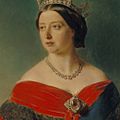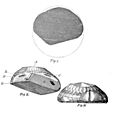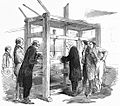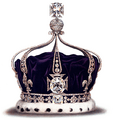Koh-i-Noor facts for kids
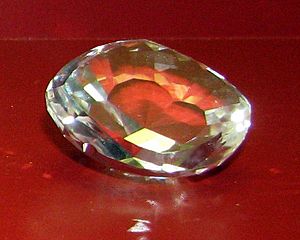
Glass replicas of the diamond before (upside down) and after it was re-cut in 1852
|
|
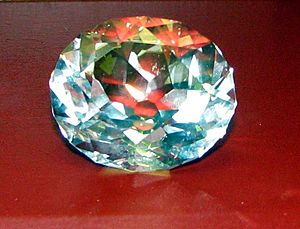 |
|
| Weight | 105.602 carats (21.1204 g) |
|---|---|
| Dimensions | 3.6 cm (1.4 in) long 3.2 cm (1.3 in) wide 1.3 cm (0.5 in) deep |
| Colour | D (colourless) |
| Type | IIa |
| Cut | Oval brilliant |
| Facets | 66 |
| Country of origin | India |
| Mine of origin | Kollur Mine |
| Cut by | Levie Benjamin Voorzanger |
| Owner | Queen Elizabeth II in right of the Crown |
The Koh-i-Noor is a very famous and one of the largest diamonds in the world. It is a special part of the British Crown Jewels. It weighs about 105.6 carats. That's like 21 grams, or about the weight of a few paperclips! We don't know its exact original weight.
This amazing diamond might have been found in the Kollur Mine in India. This mine had deep pits along the Krishna River in a place called Golconda. It's hard to know exactly when or where it was first discovered. Many stories exist about who owned it first.
The name "Koh-i-Noor" comes from Hindi–Urdu. It means "Mountain of Light." People have called it this since the 1700s. The diamond traveled through many different owners in Asia. It finally came to Queen Victoria in 1849. This happened after the British took over the Punjab region of India.
Contents
A Diamond's Journey and New Look
Originally, the Koh-i-Noor looked like other diamonds from the Mughal Empire. One example is the Darya-i-Noor, which is now in Iran. People got to see the Koh-i-Noor at The Great Exhibition in London in 1851. This big event showed off the power of the British Empire. The diamond was a main attraction. Its mysterious past and high value drew huge crowds.
At first, the diamond was displayed in a fancy birdcage. But people thought it looked dull. So, the Koh-i-Noor was moved to a case with black velvet and gas lamps. They hoped it would sparkle more. Even then, the diamond still didn't impress everyone. It had some flaws and wasn't perfectly shaped.
Prince Albert, Queen Victoria's husband, decided to have it re-cut. It was reshaped into an oval brilliant diamond in 1852. Even with its new cut, the bottom part of the diamond is quite wide. This can make it look like a black hole when you look straight at it. But experts still say it is "full of life."
The Diamond's Reputation and Royal Owners
The Koh-i-Noor has a long history of being fought over by men. Because of this, a story grew in the British royal family. It was said that the diamond brought bad luck to any man who wore it. Since it arrived in the UK, only women in the royal family have worn it.
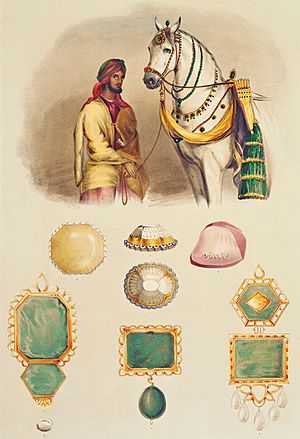
The Koh-i-Noor was officially given to Queen Victoria on July 3, 1850. This happened at Buckingham Palace. The date was chosen to celebrate the 250th anniversary of the East India Company. Queen Victoria wore the diamond in a brooch and a small crown.
After she passed away in 1901, the diamond was placed in the Crown of Queen Alexandra. She was the wife of Edward VII. Later, in 1911, it was moved to the Crown of Queen Mary. Finally, in 1937, it was set in the crown of Queen Elizabeth The Queen Mother. This was for her coronation as Queen. When The Queen Mother died in 2002, her crown was placed on her coffin during her funeral.
Where to See the Koh-i-Noor
All these crowns are on display at the Jewel House in the Tower of London. Millions of visitors see them every year. You can also see crystal copies of the diamond in the older crowns there. The original bracelet given to Queen Victoria is also on display.
A glass model of the Koh-i-Noor shows how it looked when it first came to the United Kingdom. You can also see copies of the diamond, both in its old and new shapes. These are part of the 'Vault' exhibit at the Natural History Museum in London.
Who Owns the Diamond?
After India and Pakistan became independent from the UK in 1947, both countries claimed the Koh-i-Noor. They have asked for it to be returned. However, the British government says the diamond was obtained fairly. They refer to the Last Treaty of Lahore. Because of this, they have not agreed to return the diamond.
Images for kids
-
Queen Victoria wearing the Koh-i-Noor as a brooch, by Franz Xaver Winterhalter
-
Diagram of the pre-1852 cut. Fig I. Shaded area is the base. Fig II. A: flaw; B and C: notches cut to hold stone in a setting; D: flaw created by fracture at E; F: fracture created by a blow; G: unpolished cleavage plane; H: basal cleavage plane. Fig III. Opposite side, showing facets and peak of the "Mountain of Light"
See also
 In Spanish: Koh-i-Noor para niños
In Spanish: Koh-i-Noor para niños



